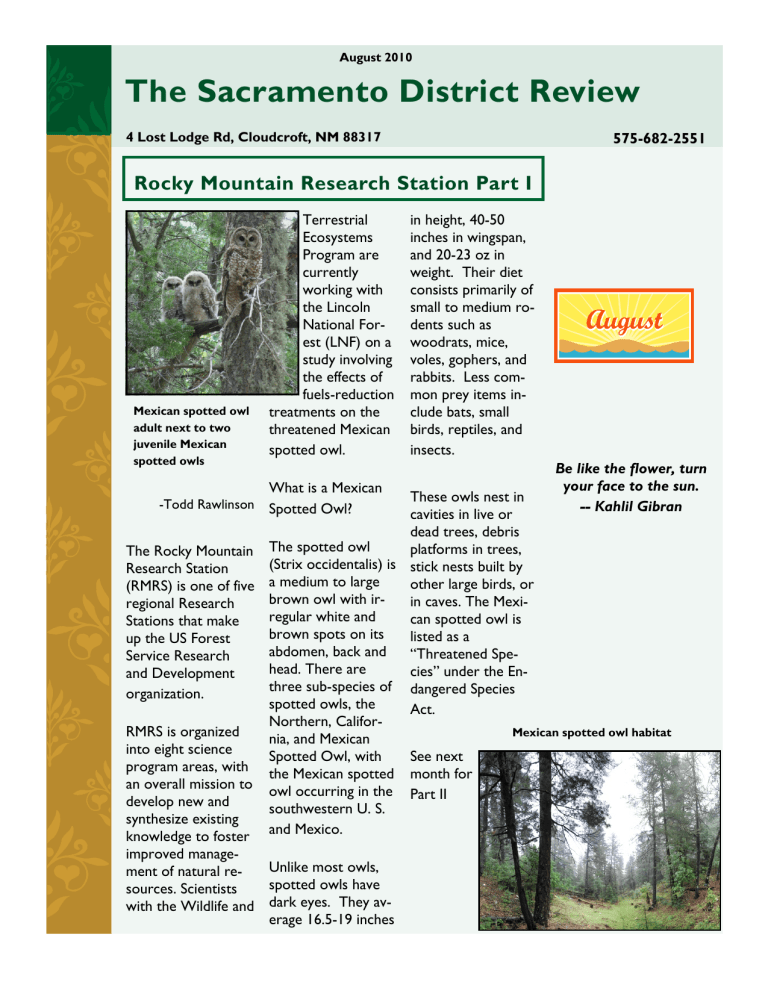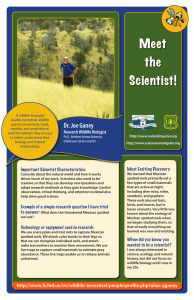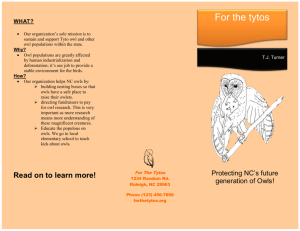The Sacramento District Review Rocky Mountain Research Station Part I
advertisement

August 2010 The Sacramento District Review 4 Lost Lodge Rd, Cloudcroft, NM 88317 575-682-2551 Rocky Mountain Research Station Part I Mexican spotted owl adult next to two juvenile Mexican spotted owls Terrestrial Ecosystems Program are currently working with the Lincoln National Forest (LNF) on a study involving the effects of fuels-reduction treatments on the threatened Mexican spotted owl. What is a Mexican Spotted Owl? in height, 40-50 inches in wingspan, and 20-23 oz in weight. Their diet consists primarily of small to medium rodents such as woodrats, mice, voles, gophers, and rabbits. Less common prey items include bats, small birds, reptiles, and insects. Be like the flower, turn your face to the sun. -- Kahlil Gibran These owls nest in cavities in live or dead trees, debris The spotted owl platforms in trees, The Rocky Mountain (Strix occidentalis) is stick nests built by Research Station a medium to large other large birds, or (RMRS) is one of five brown owl with irin caves. The Mexiregional Research regular white and can spotted owl is Stations that make brown spots on its listed as a up the US Forest abdomen, back and “Threatened SpeService Research head. There are cies” under the Enand Development three sub-species of dangered Species organization. spotted owls, the Act. Northern, CaliforRMRS is organized Mexican spotted owl habitat nia, and Mexican into eight science Spotted Owl, with See next program areas, with the Mexican spotted month for an overall mission to owl occurring in the Part II develop new and southwestern U. S. synthesize existing knowledge to foster and Mexico. improved manageUnlike most owls, ment of natural respotted owls have sources. Scientists with the Wildlife and dark eyes. They average 16.5-19 inches -Todd Rawlinson August 2010 The Sacramento District Review 4 Lost Lodge Rd, Cloudcroft, NM 575-682-2551 Tracking the Mexican spotted owl -Daniel M. Harrington The RMRS field crew has an amazing job surveying Mexican spotted owls on the Sacramento Ranger District. This season’s crew wanted to share a field experience. A universe of stars rotates slowly overhead through branches and needles. It’s 5 am and Connor has been up for nearly two hours, walking in darkness. A faint light builds in the east, but it is still dark and quiet. He flicks his headlamp back on and starts moving again, listening. He calls out four hollow notes, imitating a Mexican spotted owl. The silence of early morning folds back over the sound. He keeps walking the ridge line, listening and waiting for an owl to call back. The Forest Service radio spits static and Ryan’s voice comes through. “I found some whitewash on this side, and I’m going to try this side drainage to the north.” Whitewash is a liquid mixture that owls eject and is usually white. Ryan has found a spot where an owl perched in a tree and left a splash of whitewash on the ground beneath. It’s a good sign. Connor keys his radio, “I’ll stay on the ridge.” They are working together, covering more ground by splitting up, and both are calling the owls, hoping an owl will hear them and call back. Connor pauses again to listen, and measures the growing light in the east. Morning is coming and time is short. If they don’t find the owl, they’ll have to come back again that night and start the process over. Connor’s tired, short on sleep, and he’d rather not have to come back. He brushes sweat from his brow and refit his headlamp. Halfway through the motion, he freezes, listening. Four sonorous notes echo up from the drainage below, the last one trailing. Unmistakable. The radio hisses Ryan’s voice, “That’s our bird.” They converge on the owl. The male sits twenty feet off the ground in a Douglas fir, hooting and looking from side to side— checking his territory for any other owls. As they approached, the owl focuses on the sound of their footsteps, cocking his head slightly and watching with deep brown eyes. Monsoon Season is Here Be aware that summer rains can often produce more water than the ground can absorb, creating flash floods. Be prepared during flash flood season by staying informed of weather conditions in your area. Keep out of washes and streams during storms & never attempt to cross a flooded areas in a vehicle. Shallow water can often have a strong enough current to carry a vehicle away. Wait for water to subside or find an alternate route. Summer Office Hours The Sacramento Ranger District Office is located in the Village of Cloudcroft, at #4 Lost Lodge Road, one mile south of Highway 82 on Highway 130. We are open Monday – Saturday from 7:30 am to 4:30 pm. August 2010 The Sacramento District Review 4 Lost Lodge Rd, Cloudcroft, NM 88317 575-682-2551 Tracking the Mexican spotted owl cont. Adult Mexican spotted owl The chocolate brown of his head is speckled with white spots. He is curious about the humans stumbling around below him, but does not seem concerned. Ryan lifts a pair of binoculars, trying to see the colored bands on the bird’s left leg, while Connor looks at nearby trees. The researchers have stopped calling now that the male is hooting. What they really want to know is whether there is a breeding pair in the territory. For that reason, they’d like to find a female. The first sound is a quiet one, on the edge of hearing, but it’s a sound that the researchers are trained to hear, and both stop moving and listen. The second whistle is a little louder…it lasts a second and rises in pitch. Fifty meters away, a female owl is calling softly to her mate. beak, two dark eyes, and two wingtips. At this age, they can’t fly. They are a strange mixture of ugly and cute. One of them begins a rising hiss, begging for breakfast, while the other starts bobbing his head up and down, looking at Connor. It is bright enough now that headlamps aren’t needed, though the light is still growing and the trees are mostly silhouettes. It takes a few minutes to find the female. Ryan sees it first and points with a smile. The female looks just like the male, though her calls are different. The hard part of the morning is done, and the two researchers take their time writing notes and getting a good GPS location for the owls. This pair has pulled off a successful nest, and the colored bands on their legs indicate who the birds are. Later, this data will be entered and recorded on computers and a GIS mapping system. Beside her on a branch are two balls of downy feathers. Young owls, just out of the nest. They are mostly white down, though as they age the down will give way to real feathers. For now, the only thing poking out of the fluff is a But for now, Connor and Ryan catch their breath, and enjoy the first slanted rays of sunlight touching the tree tops, and the quiet, inquisitive company of a family of Mexican spotted owls. Slash Pit Schedule The slash pit will be open Saturday August 14th and Saturday August 28th from 9:00 a.m. to 4:00 p.m. Summer has now thrown open her emerald doors. Every part of the landscape is profuse in leaves and flowers, and "green-robed senators of mighty woods" are clothed in their most elegant array. -- Author Unknown Adult Mexican spotted owl, note the dark eyes





